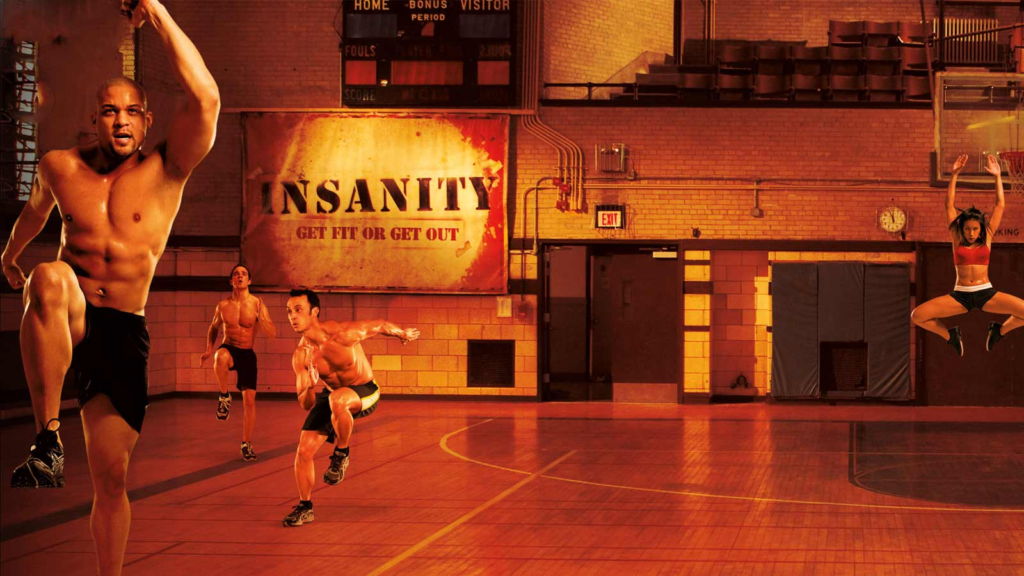Essentially Zumba on steroids, Insanity fuses callisthenics (bodyweight exercises) with martial arts and plyometric work (jump variations) to make a series of short, high-intensity workouts. And its creator, Shaun T, claims it, “Turns old-school interval training on its head.”
How so? He told us, “You work flat out in 3 to 5-minute blocks, and take breaks only long enough to gulp some air and get right back to work. It’s called Max Interval Training, because it keeps your body working at maximum capacity through your entire workout.
You keep pushing your limits – so your body has to adapt.
A slick, well-marketed pitch, but does it work? We completed the Insanity workout below, which you can also try at home, then performed a strength and conditioning autopsy to see if there’s any truth behind their claims of melted man boobs, solid six-packs and the general consensus that it’s the greatest creation in sports nutrition and exercise conditioning since the invention of the dumbbell (ancient Greece, if you’re wondering).
Exercises
Double Diamonds
Trains the shoulders, abs, glutes and thighs
- Stand with feet wider than hip-width apart
- Squat until thighs are almost parallel to the floor
- Jump touching the hands together above the head with elbows bent as you tap your heels
- Forming a diamond shape with your body in the air
- Land (ensuring you bend the knees and “cushion” your landing)
- Repeat as fast as possible for 1 minute
Stance Jacks
Trains the shoulders, abs, obliques, glutes and thighs
- Stand with feet together, arms raised to chest level (with elbows out and finger tips touching)
- Jumping into a wide squat stance
- Push the hips back as you reach your left hand toward the right foot with the right arm extended behind you for balance
- Jump back to the start
- Repeat on opposite side
- Repeat as fast as possible for 1 minute
**Hit The Floor
© Rex Features

Trains the abs, glutes and thighs
- Stand with feet shoulder width apart and arms down
- Crouch, placing the right hand on the floor near a left “instep” with the left hand behind for balance
- Jump, reaching arms overhead, to land in a crouch position with the left hand now bear your right “instep”
- You essentially land in a “mirror” opposite of the initial position
- Repeat as fast as possible for 1 minute
**Power Jump
** Trains the abs, glutes and thighs
- Stand with feet shoulder width apart and arms down
- Squat while extending your arms behind you
- Jump bringing the knees towards your chest as you touch hands to thighs
- Land (bend the knees and “cushion” your landing)
- Repeat as fast as possible for 1 minute
**The Heisman
© Getty Images

Trains the arms, abs, shoulders, glutes and thighs
- Stand with feet shoulder width apart
- Elbows bent, arms close to the body
- Hop on the left foot, bringing the right knee toward the chest
- Drive the left arm forward and right arm back like a sprinter
- Quickly hop onto the right foot, reversing the motion
- Repeat as fast as possible for 1 minute
Switch Kicks
Trains the triceps, back, abs shoulders, glutes and thighs
- Sit with knees bent, feet flat, palms behind you and finger tips pointing towards your heels
- Keeping the hands and feet planted, raise hips off the floor and alternate kicking in the air
- Left and right leg as quick as possible
- Repeat as fast as possible for 1 minute
What’s The Science behind the Insanity Workout?
The Insanity Workout is good, but not as great as their marketing literature would have you believe. In 1991 the National Strength and Conditioning Journal stated, “Is there a single, perfect workout? A workout with the best weight training, plyometric, flexibility and endurance exercises? A workout with the precise number of sets and repetitions? A workout that tells the athlete exactly how much weight to use? The answer is “No”.
Basically, there is no perfect workout plan. Of course the company behind the Insanity creation, the Beachbody Corporation, would beg to differ. With glowing testimonials and equally as impressive transformation stories, they claim it’s, “Everything you need to get in the best shape of your life”. But research shows the use of the word, “Everything” might be a stretch. Here’s why.
Plyometric work is best performed
‘fresh’
On the Insanity website it’s written, “Plyometrics for insane legs and glutes.” Let’s unravel this. Plyometric training can trace its origins back to the old Soviet Union during the Fifties. A time when the Soviet’s athletic endeavours were considered by many to be at the cutting-edge of strength and conditioning.
American coaches noticed that, prior to a competition, Soviet athletes were performing jumping-based drills. This seemed odd and was completely different to traditional static stretching. This was thanks to pioneering strength coach, Dr. Yuri Verkhoshansky, and a training protocol he called the, “Depth Jump.”
Verkhoshansky would have athletes drop off a box, land on the floor – whilst absorbing the shock – only to then instantly jump as high as they possibly could. Later labelled, “Shock Training” in reference to the body’s ability to absorb the shock/impact, it was believed one short-term adaptation to the “Depth Jump” was a higher vertical jump compared to a static jump. Research would later reveal this was because Verkhoshansky was able to play around with the elasticity of the muscles and tendons by positively manipulating the body’s stretch-shortening cycle.
Essentially, this is where the muscles contract eccentrically (the muscles lengthen) which is followed by an immediate concentric contraction (the muscles shorten). This – based on research from the School of Kinesiology at the University of Zagreb in Croatia – has been shown to improve the concentric phase resulting in increased force production and output. This explains why during a, “Depth Jump” athletes were able to jump higher. They effectively used the ‘elastic energy’ built-up during the eccentric phase (when landing) to then use during the concentric phase (the jump itself).
But rarely did Dr. Yuri Verkhoshansky advocate using plyometric training as part of a circuit when the athlete was fatigued. This would be counterproductive to the sole objective to this form of training – to condition the body to produce greater power by training the muscles to contract more quickly and forcefully from an actively pre-stretched position.
Can Insanity really ‘melt fat’?
Yes and no. But make no mistake – it’s just High Intensity Interval Training and your body doesn’t know the difference between a H.I.I.T workout on the treadmill and a heavily advertised Insanity DVD. Physiologically the result is the same. Working hard at a high intensity for short periods of time (between 30 to 80 seconds) followed by a period of low intensity training or complete rest (40 to 120 seconds) which you repeat (between 15 to 30 minutes) has been found by researchers from Laval University in Canada, to burn more fat compared to traditional cardio.
So, the Insanity workout is good, but it’s not revolutionary.
It’s also a practical training protocol if you have no equipment or are short on time. But don’t be fooled by the marketing. Your body must be continually subjected to a range of stimuli to consistently improve.









Be the first to write a comment.